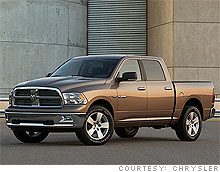Chrysler's next fear: High gas prices
With Fiat's fuel-efficient cars more than a year away from helping Chrysler, the company prays rising gas prices won't kill its bread-and-butter truck and SUV sales.
 |
| The redesigned Dodge Ram pick-up is generally regarded as Chrysler Group's most competitive product. |
NEW YORK (CNNMoney.com) -- In the auto business, timing really is everything.
Even as Chrysler embarks on its path to resurgence, its short-term survival is threatened by rising gas prices and a product line still dominated by trucks and SUVs.
Fiat of Italy, stands ready to assist with its fuel-efficient small cars. But those won't be ready for at least a year.
That means Chrysler has to hope that gas prices don't spike this summer.
"If gas prices continue to go up, the challenge for Chrysler becomes greater and greater," said Tom Libby, president of the Society of Automotive Analysts.
Chrysler's best stuff is still its biggest stuff. Its most well-regarded vehicles are the new Dodge Ram pick-up, the Dodge Challenger muscle car and the Chrysler 300C, a V8-powered sedan -- not the type of vehicles consumers flock to when gas prices are high.
This problem is not specific to Chrysler. All domestic manufacturers face challenges when gas prices go up. Import carmakers have been focused on selling small cars more than the SUV-loving U.S. carmakers.
When consumers shift to smaller cars that command lower prices and deliver slimmer profits American automakers struggle to compete.
Last summer, as gas prices rose toward $4 a gallon, sales of the Chrysler 300 dropped more than 40% from the year before. Sales of the Dodge Durango and Chrysler Aspen full-size SUVs also plummeted. Chrysler eventually took the big SUVs out of production altogether as inventories backed up.
Sales of GM (GMGMQ) and Ford's (F, Fortune 500) big trucks dropped, too, but at least they had some decent small, fuel efficient cars to offer shoppers. Market share of the Ford Focus and Chevrolet Cobalt held tight as sales of compact car sales took off.
Chrysler's smaller cars couldn't stand up to the competition: the Dodge Caliber enjoyed market share spike at first, but it soon faded and went back to losing share, as it had been before, even while gas prices stayed high.
"GM has more products in the pipeline and, right now, they have more competitive products in key segments," said Libby.
Since last year, GM's Chevrolet Malibu mid-size sedan has gained market share against its foreign competitors in spite of the crisis gripping the automaker and the industry. Ford has made even more headway with its new Fusion sedan, more than doubling its share of the market since the beginning of 2008.
Chrysler's Sebring sedan, meanwhile, has gone from about 5.5% of the mid-size car market at the start of 2008 to just 1.4% today.
Besides mid-size sedans and small cars, small crossover SUVs have become a key segment as consumers look to save gas while still getting SUV functionality. Ford already has the popular Ford Escape and Mercury Mariner in that segment, which also includes the Honda CR-V and Toyota Rav4.
GM will introduce three new small crossover vehicles in the next few weeks: The redesigned Chevrolet Equinox, the GMC Terrain and a new Cadillac SRX.
Meanwhile, Chrysler offers the Dodge Nitro. While it may look like a crossover SUV, it's actually a truck-based SUV based on the Jeep Liberty. It rides rougher than a real crossover SUV and its fuel economy is 25% worse than that of a V6-powered Ford Escape. Also, the Nitro isn't even available with a 4-cylinder engine, which Ford's Escape offers.
"If the Nitro were a good small SUV, or if they had a family sedan that was anywhere close to the Malibu, they wouldn't be where they are today," said Jake Fisher, a senior automotive engineer for Consumer Reports magazine.
Chrysler's recently redesigned Dodge Ram truck is very good, he said, but that just continues Chrysler's traditional reliance on big trucks.
Chrysler does have the Journey, a mid-size crossover SUV with an available third row of seats. While it doesn't match up to what many competitors offer, Fisher said, the Journey is decent. It gives the carmaker something with which to compete in that segment.
He contrasts that to the small Caliber which is essentially a small SUV playing the role of a compact car. In fact, Chrysler markets the nearly identical Jeep Compass as a small crossover SUV.
"Since Chrysler lost the Neon and went with the Caliber, they essentially don't have a small car at all," he said.
Fortunately for Chrysler, the current rise in gas prices doesn't signal a run-up like last summer's unprecedented rise, said Jeff Schuster, executive director of forecasting for J.D. Power and Associates.
"If you look historically at the summer rise, the levels we're at right now are very similar to that," he said.
Gas prices will start creating a real problem for Chrysler Group if they begin approaching the $4.00 a gallon mark, Schuster said. That's what started a panic shift in the market last year as consumers began a sudden rush to small cars.
Chrysler admits that it's hoping gas prices don't spike too high.
"None of us wants to see $4.50 a gallon gas," Chrysler spokesman Scott Brown said. Any carmaker would say the same thing, though, he noted.
In the meantime, Brown said, having the company's best product be a large pick-up isn't such a bad thing. Americans still like big trucks and they remain profitable vehicles. "If we had to have one thing to hang our hats on, I think we'd want it to be the Ram," he said. ![]()


